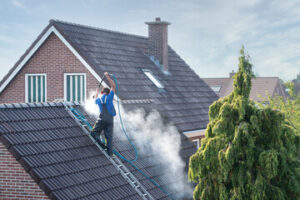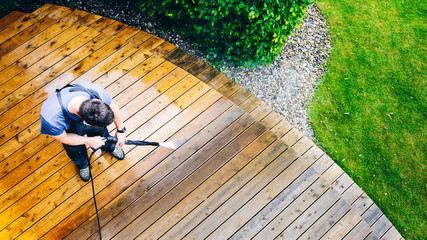What You Should Know About Roof Cleaning
Roof Cleaning Sarasota involves the use of a chemical solution to remove dirt, stains, and growth. It is important to do regularly to avoid moss, algae, and lichen, which retain moisture and weaken asphalt shingle shingles.

Regular roof cleaning also helps to preserve a home’s aesthetic and increase resale value. It also minimizes the risk of damage to the roof, which can void some roof warranties.
Debris build-up is a major cause of roof problems and is why it is important to have debris removed at least annually. Debris can clog roof drains and gutters, allow moisture to seep through the roof, trap pests, and can even damage roof tiles or shingles.
The easiest way to remove debris is with a blower. This is a great option because it doesn’t require any climbing up on the roof and doesn’t damage the shingles. The downside to this method is that the debris often lands on the ground. Also, if there is a lot of debris, it can create a big mess in the yard and may need to be blown again later.
Another simple way to remove debris is to use a broom or brush. This is a good choice if there are only a few small branches or leaves on the roof. Just be careful not to over-brush, as this can damage the shingles. Afterward, a garden hose or bucket should be used to wash away the remaining debris.
Some contractors will offer to use a pressure washer to clean the roof. However, the use of a high-pressure hose can damage or dislodge the shingles and may actually increase the chances of a leak or roof failure. Additionally, the harsh chemicals in these cleaning solutions can wreak havoc on landscaping and pollute local waterways and wildlife.
When hiring a contractor to perform this task, be sure they are experienced in using this type of equipment. The contractor should also be insured and have a valid business license. In addition, they should be knowledgeable about the different roofing materials and can explain the advantages of each.
In addition to cleaning the roof, a thorough inspection should be performed to check for any damage or wear and tear. This includes examining the shingles for any areas that look damaged or need to be replaced, as well as inspecting the gutters and roof drains for clogs. It is also a good idea to have the gutters and drains cleaned out while the roof is being cleaned. This can prevent water from backflowing and flooding into the building or into the basement.
Bleach Solution
Bleach is very effective in removing filth from roofs and preventing further growth of algae, moss and mildew. When used correctly, it will not damage shingles or asphalt shingles. However, if bleach is mixed in the wrong ratio or is applied too heavily, it can cause deterioration of these materials and lead to leaks and premature failure of the roof. It is therefore important to use a cleaning solution that is safe for the roof’s materials and to follow the recommended application methods.
A 50:50 mixture of laundry strength liquid chlorine bleach and water is often used to remove moss and algae from roofs. This can be applied by saturating a sponge or spraying the solution onto the surface of the roof. It is important to allow the solution to dwell on the roof for 15 to 20 minutes before rinsing thoroughly with low-pressure water. Extended dwell times can cause the solution to erode the surface of the roof, which can damage or stain shingles.
After the bleach solution has been rinsed, the area should be thoroughly wiped down with clean water to remove any residual product and to allow the roof to dry completely. If there is any lingering algae or moss, a second application of the cleaning solution may be necessary. After a second application, the remaining growth should disappear and wilt away with subsequent rainstorms. Alternatively, you can use a percarbonate cleaner or hydrogen peroxide to kill the remaining growth on your roof.
The use of bleach to clean a roof should be done on a cloudy day, as direct sun exposure can quickly evaporate the solution. It is also recommended to open windows to provide good air circulation during the cleaning process. It is also important to wear rubber gloves, eye protection and a face mask when handling any cleaning chemical, as it can be harmful to your health.
When using a chlorine bleach solution, it is also advisable to lay down plastic tarps to protect any landscaping or shrubbery below the roof. Sodium hypochlorite can irritate plants and grass, and if it comes into contact with them, it may discolor their leaves or even kill them. To prevent this, it is a good idea to thoroughly wet any plants and shrubs with plain water before covering them with plastic.
Pressure Washing
Unless you are experienced at climbing on the roof and have proper safety equipment, it’s recommended to leave this part of the cleaning to an expert. The constant assault from the elements can quickly wear away a roof, leaving it in need of a good cleaning. Pressure washing can damage delicate shingles, dislodge tiles and loosen or remove the granules that protect the underlying roofing materials, leading to further problems.
A professional will use a low-pressure rinsing process that is typically just slightly stronger than the force created by a garden hose with a spray nozzle. This helps to avoid the need for climbing onto the roof and can also help to ensure that the roof is cleaned without damaging or removing the granules. This can be especially important for older or brittle roofing materials, or clay tiles that are covered in a thick layer of dirt and grime.
The cleaning solution used to wash a roof will vary depending on the specific needs of the project, but usually contains an alkaline such as sodium hypochlorite (commonly known as caustic soda), which breaks down a variety of organic substances, including moss, mildew and algae. It’s often combined with bleach or other chemical agents that kill spores and leave the surface free from organic growth.
It’s important to work in small sections when using a pressure washer to prevent the soapy detergent from drying too fast and leaving behind unsightly streaks or sticky residues that attract more dirt. It’s also a good idea to work from a ladder rather than getting on the roof itself, as walking around on a wet, slippery surface can lead to serious injury.
It’s also a good idea to make sure the nozzles on your pressure washer are set correctly before you start washing. The nozzles are typically color coded, with a red, 0-degree nozzle offering the highest concentration of water spray and a black soap nozzle delivering the lowest. If you have a multi-stage power washer, it’s helpful to start with the highest-pressure nozzle and move down to the lower-pressure options as needed.
Soft Washing
When cleaning a roof soft washing is an effective and safe method of getting rid of algae, mildew, and other biological contaminants. This method of cleaning uses detergents and other cleaning solutions that are applied with water at low pressure. The solution seeps into the cracks and crevices of a roof, killing any organisms that live there. It also lifts dirt and stains, leaving the surface of the roof clean.
This cleaning technique is preferred by roofing experts, as it avoids the damage that high amounts of pressure can do to a roof. It’s especially important to use a soft wash when the area to be cleaned is painted; areas that adjoin rooted plants; and materials adhered with mortar and sand, such as brick, paver, tile, stucco and vinyl siding.
The chemical solution in a soft wash includes bleach, which kills any mold and mildew spores, as well as algae and moss. It is also rich in surfactants, which aide in the cleaning process by loosening, trapping and carrying away dirt. This is a great way to remove organic stains from your roof, as the solution also leaves behind a growth-inhibiting residue that will prevent future fungal activity.
A properly trained and experienced professional should be used to perform soft wash cleaning on a roof. They can be able to tell when a roof needs to be cleaned with a more aggressive approach, and they will know how much pressure to apply. If you try to clean a roof yourself, you may end up damaging your shingles and potentially voiding the warranty on your roof.
Using the right equipment and following proper safety procedures will ensure that your home is safe from potential damage from harsh chemicals and high-pressure water. A professional will take the time to inspect a roof to find out if it’s suitable for soft washing, and they will ensure that all debris is removed before proceeding with the cleaning process. They will also take steps to protect the surrounding plants from water damage and stains. They will also train the clients on how to walk on a roof safely, so they can reduce the impact that their movement has on the structure of the building.

